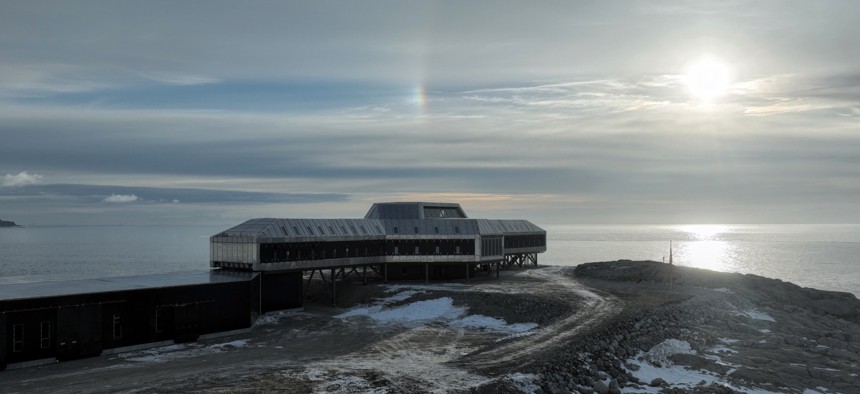
China's Qinling Station, the country's fifth Antarctic research station, began operations in February. Zhu He/Xinhua via Getty Images
New Arctic strategy? Good. Now do one for the Antarctic
China and Russia aren’t limiting their adventurism to the northern polar region.
As the Defense Department prepares to release its new Arctic strategy, Pentagon planners should expand their perspective to the opposite pole: Antarctica, whose resources, geostrategic location, and potential military uses are drawing Chinese and Russian interest.
For nearly a half-century, the Antarctic was at least somewhat off-limits to economic and national-security efforts. In 1959, the United States, the Soviet Union, and ten other countries signed the Antarctic Treaty System to manage conflicting interests and activities there. The subsequent creation of the Commission for the Conservation of Antarctic Marine Living Resources installed concrete institutions to keep the South Pole free of geopolitical scuffles.
But as post-Cold War competition has become more acute and diverse, Russia and China—who are members of these forums—began to disregard these safeguards to tighten their grip on this region. For instance, Russia’s navy has been leading oceanographic expeditions into the Southern Ocean, such as the Admiral Vladimirsky expedition, which raise concerns that these trips reach beyond scientific research purposes and may be for potential naval intelligence and surveillance purposes. Russian defense companies have also been using the continent for an increasing number of aerial tests for military-grade drones.
Experts worry that the Kremlin sees the region “as a space for geopolitical, geoeconomic, and geo-scientific competition…including via military means.” Russia already has an Antarctic action plan for 2030, which highlights military and intelligence purposes like tracking missiles and increasing its global command and control capabilities.
Nor can international standards and accords be counted upon to check Moscow and Beijing, whose flouting of norms is reflected in near-daily reporting on things like a possible Russian nuclear space weapon, China’s actions in the South China Sea, and so forth.
Moreover, both Russia and China recently blocked an international agreement to create new conservation areas in the South Pole, revealing their intentions to use the region for ulterior motives.
China has been even more assertive than Russia. In November 2014, President Xi Jinping declared that China aims “to become a polar great power,” not just an Arctic one. Its Belt and Road Initiative features plans to build itself into a “maritime powerhouse,” including explicit ambitions to expand its presence on the South Pole. In February of last year, China announced plans to construct new ground facilities to support satellite operations. Last month, China completed the construction of a huge new base in Antarctica, right within SIGINT range of our critical partners Australia and New Zealand.
I recently visited Hobart and Christchurch, their respective gateway cities to Antarctica, where Aussies and Kiwis are viewing Chinese activities with some trepidation. Experts are concerned that these locations are “inherently dual-use” with potential threats to the security of America and its allies. Ominously, growing Chinese hypersonic capabilities may seek to exploit America’s missile defense vulnerabilities from the South Pole.
While we all would like to believe that the Antarctic Treaty System would suffice to keep the southern continent from becoming a theater of international competition, hope is not a strategy. In light of Chinese and Russian adventurism and revisionism, the United States, in concert with our partners and allies, must develop an Antarctic strategy along the lines of what we are doing about Arctic challenges.
This must start with proper inter-agency coordination and action. With increasing security and military implications for the Antarctic, the Department of Defense must become more active in regional planning efforts to deter malign activities there. Other than fleeting and under-funded past programs like Operation Deep Freeze, the Pentagon’s involvement in the region has been lacking. During my time as the Deputy Assistant Secretary for Defense with regional responsibility for Antarctica, I must candidly say that at best it was an afterthought from a strategic perspective given competing priorities for resources and attention. This must be corrected to match what DoD has been doing in the Arctic: devising a strategy and implementing it through an Antarctic Strategy and Global Resilience Office as it has done for the high north. Or, at a minimum, expanding the current DoD policy efforts to cover both poles appropriately.
Our global competition with Russia and China will remain a central component of our foreign and defense policies. We cannot wish away our adversaries’ malign intent regarding Antarctica. By recognizing today’s national security implications of the Antarctic and placing appropriate Pentagon emphasis there, we can avoid falling behind Russia and China in the region and enhance much-needed stability and deterrence to the global order.
Heino Klinck was the Deputy Assistant Secretary of Defense for East Asia, 2019-21. His area of responsibility included Australia, New Zealand, and Antarctica.
NEXT STORY: Two ways to fix Army recruiting



